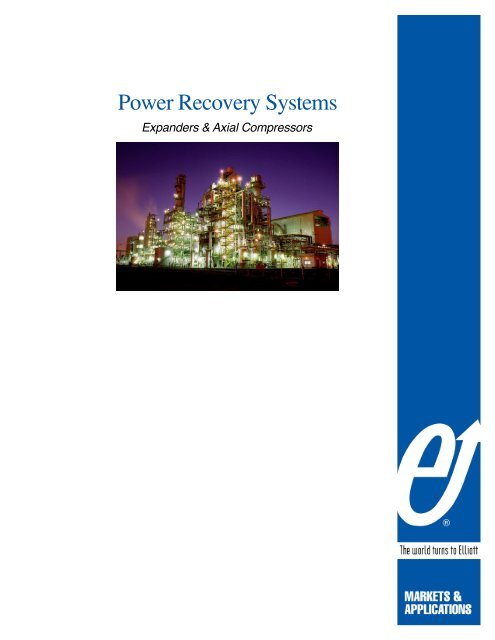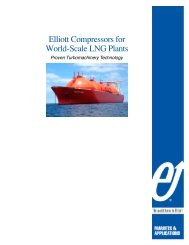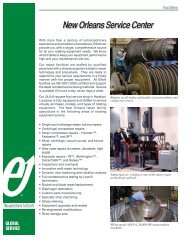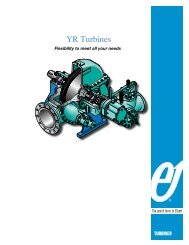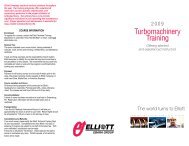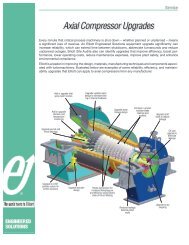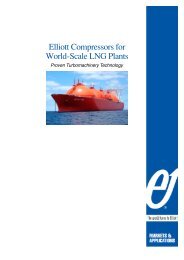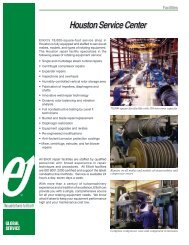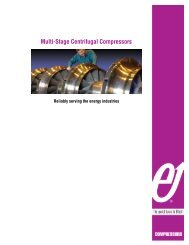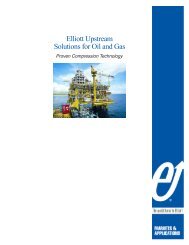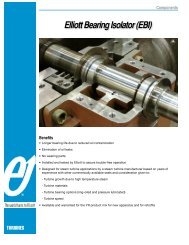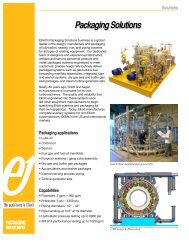Power Recovery Systems - Elliott Turbomachinery
Power Recovery Systems - Elliott Turbomachinery
Power Recovery Systems - Elliott Turbomachinery
You also want an ePaper? Increase the reach of your titles
YUMPU automatically turns print PDFs into web optimized ePapers that Google loves.
<strong>Power</strong> <strong>Recovery</strong> <strong>Systems</strong><br />
Expanders & Axial Compressors
The Leader in <strong>Power</strong> <strong>Recovery</strong> Expanders<br />
In 1963 <strong>Elliott</strong> designed and manufactured the first<br />
hot gas expander for capturing waste flue gas energy<br />
from the fluid catalytic cracking (FCC) process.<br />
<strong>Elliott</strong>’s technological innovation enabled refiners for<br />
the first time to recover the heat energy from a waste<br />
flue gas stream that was previously lost through pressure<br />
reducing valves.<br />
In the decades since this engineering breakthrough,<br />
<strong>Elliott</strong> has continued to enhance its expander design<br />
to reflect operating experience and FCC process innovations.<br />
<strong>Elliott</strong>’s development of new alloys and metallurgical<br />
treatments has resulted in expanders that<br />
match the reliability and availability of other equipment<br />
in less arduous FCC services, despite the high<br />
operating temperatures and the corrosive effect of<br />
the catalyst in the flue gas stream. Superalloys used<br />
for rotor disks and blades offer an excellent combination<br />
of strength, toughness, creep, and fatigue<br />
resistance for high temperature applications. Several<br />
Exhaust casing<br />
View port<br />
Rotating blades<br />
Inlet casing<br />
Nose cone<br />
Rotor disk<br />
Rotor shaft<br />
<strong>Elliott</strong> expanders have remained in operation for<br />
more than seven years with the original set of blades.<br />
<strong>Elliott</strong> power recovery expanders lead the industry in<br />
efficiency, reliability, low maintenance costs and easy<br />
maintenance leading to shorter turnaround times.<br />
Today, as environmental concerns grow, the efficiency<br />
and reliability of <strong>Elliott</strong>’s power recovery expanders<br />
enable operators to reduce their carbon footprint<br />
(see diagram on page 4). The power recovered by<br />
the expander is often sufficient to drive both an air<br />
compressor for the FCC process as well as a generator.<br />
The efficient conversion of waste heat to rotational<br />
power reduces a facility’s steam requirements as well<br />
the power it draws from the grid. <strong>Elliott</strong> expander<br />
strings deliver up to 60,000 horsepower (45 MW) of<br />
useful power from waste gas streams (see left chart<br />
for frame sizes).<br />
Hot mechanical test of TH expander<br />
Site installation of an expander power recovery unit<br />
2
High Efficiency, High Flow Axial Compressors<br />
<strong>Elliott</strong>’s axial compressors are often paired with power<br />
recovery expanders to supply combustion air to the<br />
FCC process. These highly efficient machines are<br />
well suited for high flow, medium pressure applications<br />
beyond the flow capacity of centrifugal compressor<br />
designs. <strong>Elliott</strong> designs the aerodynamic<br />
components to maintain high efficiency levels over<br />
broad operating ranges, resulting in significant energy<br />
savings. Efficient, reliable axial compressors from<br />
<strong>Elliott</strong> are also used in air separation plants, blast<br />
furnace blowers, nitric acid plants, synthetic fuel processing<br />
and aerodynamic testing.<br />
Thrust bearing<br />
Inlet casing<br />
Rotor blades<br />
Adjustable guide<br />
vane cover<br />
Discharge casing<br />
To assure high reliability and ease of maintenance,<br />
<strong>Elliott</strong> axials have a dedicated adjustable guide stator<br />
vane cover for routine inspections. <strong>Elliott</strong> axial<br />
compressors offer direct access to bearings and<br />
seals with individual covers for reduced field service<br />
time. Axial compressors also provide weight and size<br />
advantages which translate into savings on foundation<br />
and support structures as well as floor space requirements.<br />
<strong>Elliott</strong>’s high efficiency robust blading for<br />
reduced plant emissions is the result of many years<br />
of engineering and experience in both steam turbines<br />
and axial compressors.<br />
Axial compressor assembly shown with bearing covers<br />
Testing an axial compressor<br />
3
How to Improve Plant Efficiency<br />
Process:<br />
0.<br />
1.<br />
2.<br />
3.<br />
4.<br />
5.<br />
6.<br />
7.<br />
8.<br />
Air enters the inlet filter and flows through the main<br />
air compressor<br />
Pressurized air is injected into the regenerator for<br />
combustion reaction.<br />
Feed (heavy gas oils) is pumped to the reactor.<br />
Catalyst is combined with the feed and cracking<br />
reaction takes place.<br />
Spent catalyst with coke build-up is returned to<br />
the regenerator for recovery.<br />
Cracked gaseous products are separated from<br />
the catalyst in cyclones and flow overhead to the<br />
fractionator.<br />
Coke build-up on the catalyst combusts,<br />
producing hot flue gas.<br />
Without the expander, flue gas flows into the<br />
pressure reducing valve, an orifice chamber, and<br />
leads to the waste heat boiler.<br />
When an <strong>Elliott</strong> power recovery system is installed,<br />
flue gas flows to the third stage separator (TSS) for<br />
fine catalyst particles removal.<br />
9. TSS overhead stream flows to the expander for<br />
power recovery.<br />
10. <strong>Power</strong> is generated, and low pressure flue gas<br />
enters the waste heat boilers for thermal energy<br />
recovery.<br />
11. Exhaust gas discharged in the stack.<br />
Typical FCC process with and without <strong>Elliott</strong> power recovery system<br />
In a typical FCC process without a power recovery expander, a large amount of valuable kinetic energy is lost<br />
by passing the flue gas through a pressure reducing valve. Because coke is burned from the catalyst, enough<br />
thermal energy is generated from the combustion reaction to run the expander and generate additional electrical<br />
power. Based on 5¢ per kWh energy cost, an <strong>Elliott</strong> 30 MW expander can save refiners over $13 million in one<br />
year. In this configuration, the high pressure steam used to drive the compressor, can now be converted in to<br />
more desirable low pressure steam by passing it through the same steam turbine to generate additional power<br />
from the generator. Overall, <strong>Elliott</strong>’s power recovery process reduces the facility’s carbon footprint and energy<br />
consumption.<br />
4
<strong>Elliott</strong> Hot Gas Expanders<br />
TH-Model<br />
TH-85-1<br />
TH-100-1<br />
TH-120-1<br />
TH-140-1<br />
Inlet Nozzle<br />
inch (mm)<br />
48<br />
(1 220)<br />
56<br />
(1 420)<br />
66<br />
(1 676)<br />
77<br />
(1 956)<br />
Approximate Dimensions and Weights<br />
Exhaust Nozzle<br />
inch (mm)<br />
66<br />
(1 680)<br />
78<br />
(19 80)<br />
84<br />
(2 134)<br />
108<br />
(2 743)<br />
Length<br />
inch (mm)<br />
118<br />
(2 990)<br />
134<br />
(3 400)<br />
156<br />
(3 960)<br />
175<br />
(4 450)<br />
Width<br />
inch (mm)<br />
106<br />
(2 700)<br />
138<br />
(3 505)<br />
128<br />
(3 245)<br />
178<br />
(4 520)<br />
<strong>Elliott</strong> Axial Compressors<br />
Height<br />
inch (mm)<br />
109<br />
(2 770)<br />
127<br />
(3 240)<br />
145<br />
(3 683)<br />
175<br />
(4 450)<br />
Weight<br />
lb (kg)<br />
26,500<br />
(12 000)<br />
34,000<br />
(15 400)<br />
78,700<br />
(35 700)<br />
91,000<br />
(41 300)<br />
Information is of general nature; it is intended to allow preliminary estimates only, actual sizes and weights will vary depending on specific application requirements.<br />
A-Model<br />
21A<br />
26A<br />
32A<br />
37A<br />
44A<br />
Inlet Nozzle inch<br />
(mm)<br />
48<br />
(1 220)<br />
54<br />
(1 370)<br />
72<br />
(1 829)<br />
84<br />
(2 134)<br />
100<br />
(2 540)<br />
Exhaust Nozzle<br />
inch (mm)<br />
30<br />
(760)<br />
36<br />
(920)<br />
42<br />
(1 067)<br />
54<br />
(1 372)<br />
66<br />
(1 680)<br />
Approximate Dimensions and Weights<br />
Weight for 13<br />
stage unit lb (kg)<br />
36,000<br />
(16 330)<br />
59,000<br />
(26 760)<br />
87,960<br />
(39 900)<br />
156,000<br />
(70 760)<br />
237,000<br />
(107 500)<br />
Weight/additional<br />
stage lb (kg)<br />
500<br />
(230)<br />
910<br />
(410)<br />
1,480<br />
(671)<br />
2,140<br />
(970)<br />
3,500<br />
(1 590)<br />
Length 13 Stage<br />
inch (mm)<br />
132<br />
(3 360)<br />
175<br />
(4 450)<br />
182<br />
(4 623)<br />
237<br />
(6 030)<br />
276<br />
(7 010)<br />
Diff length/stage<br />
inches (mm)<br />
4.4<br />
(112)<br />
4.9<br />
(124)<br />
5.9<br />
(150)<br />
6.5<br />
(165)<br />
7.9<br />
(201)<br />
Width inch (mm)<br />
96<br />
(2 430)<br />
110<br />
(2 800)<br />
130<br />
(3 300)<br />
148<br />
(3 760)<br />
180<br />
(4 570)<br />
Information is of general nature; it is intended to allow preliminary estimates only, actual sizes and weights will vary depending on specific application requirements.<br />
Height<br />
inch (mm)<br />
80<br />
(2 020)<br />
99<br />
(2 520)<br />
119<br />
(3 030)<br />
142<br />
(3 610)<br />
169<br />
(4 300)<br />
6
Comprehensive Global Service<br />
Field Service<br />
<strong>Elliott</strong>’s field service capabilities cover the entire<br />
spectrum of service and support, from technical<br />
assistance for installation and commissioning to<br />
experienced project managers, technicians and skilled<br />
labor for overhauls, repairs and ongoing maintenance<br />
programs. Our field service teams are equipped<br />
with the tools needed to get the job done, including<br />
portable, fully equipped machine shops and balance<br />
machines.<br />
Rerates & Upgrades<br />
Repair Facilities<br />
<strong>Elliott</strong> Rerate Services maximizes your long-term<br />
investment in critical rotating equipment from <strong>Elliott</strong><br />
or any other manufacturer. Through rerates, upgrades<br />
or reapplications, <strong>Elliott</strong> can improve machinery<br />
performance to enhance operating efficiency, reduce<br />
operating costs and support increased plant capacity.<br />
Service Parts Organization<br />
<strong>Elliott</strong>’s network of full-service service repair shops are<br />
strategically located throughout the world to service<br />
and repair <strong>Elliott</strong> and non-<strong>Elliott</strong> turbomachinery. Each<br />
shop is staffed by skilled personnel with extensive<br />
experience in repair techniques and procedures<br />
ranging from inspections and overhauls to weld repair,<br />
specialty machining and fabrication.<br />
Rotor Storage<br />
Many of <strong>Elliott</strong>’s service shops offer climate controlled<br />
rotor storage facilities. When a spare rotor is needed<br />
quickly, whether due to a catastrophic event,<br />
equipment failure or routine overhaul, <strong>Elliott</strong> service<br />
teams help to get the equipment back in service with<br />
minimal downtime.<br />
<strong>Elliott</strong>’s ISO 9001 certified Service Parts group is<br />
dedicated to providing customers with the confidence<br />
and cost savings associated with high quality,<br />
original <strong>Elliott</strong> parts. Dedicated machining centers,<br />
extensive finished parts inventories, and customer<br />
support available 24 hours a day, seven days a week<br />
mean that customers receive the precise parts they<br />
need quickly and reliably. Service Parts engineers<br />
work closely with customers to develop tailored<br />
parts management programs, including inventories,<br />
routine maintenance and upgrade kits, and pricing<br />
agreements.<br />
Training<br />
<strong>Elliott</strong> regularly trains machine operators, mechanics,<br />
engineers and instrumentation personnel in the proper<br />
operation and maintenance of <strong>Elliott</strong> equipment. <strong>Elliott</strong><br />
training conveys the knowledge and confidence that<br />
translate into a safer work environment, enhanced<br />
operating efficiency, and extended equipment life.<br />
<strong>Elliott</strong> offers training at its own facilities, as well as at<br />
customer sites and tailored to customer requirements.<br />
7
901 North Fourth Street<br />
Jeannette, PA 15644-1473, USA<br />
(Tel) 724-527-2811 (Fax) 724-600-8442<br />
www.elliott-turbo.com<br />
2001 W. Sam Houston Pkwy, North<br />
Houston, Tx 77043-2498<br />
(Tel) 713-984-3800 (Fax) 713-984-3905<br />
For a complete contact listing of our global sales and service<br />
network, please contact us at www.elliott-turbo.com<br />
<strong>Elliott</strong> Company reserves the right to modify the design or<br />
construction of the equipment described in this bulletin<br />
and to furnish it, as altered, without further reference to the<br />
illustrations or information contained herein.<br />
©<strong>Elliott</strong> 8 Company 2009


